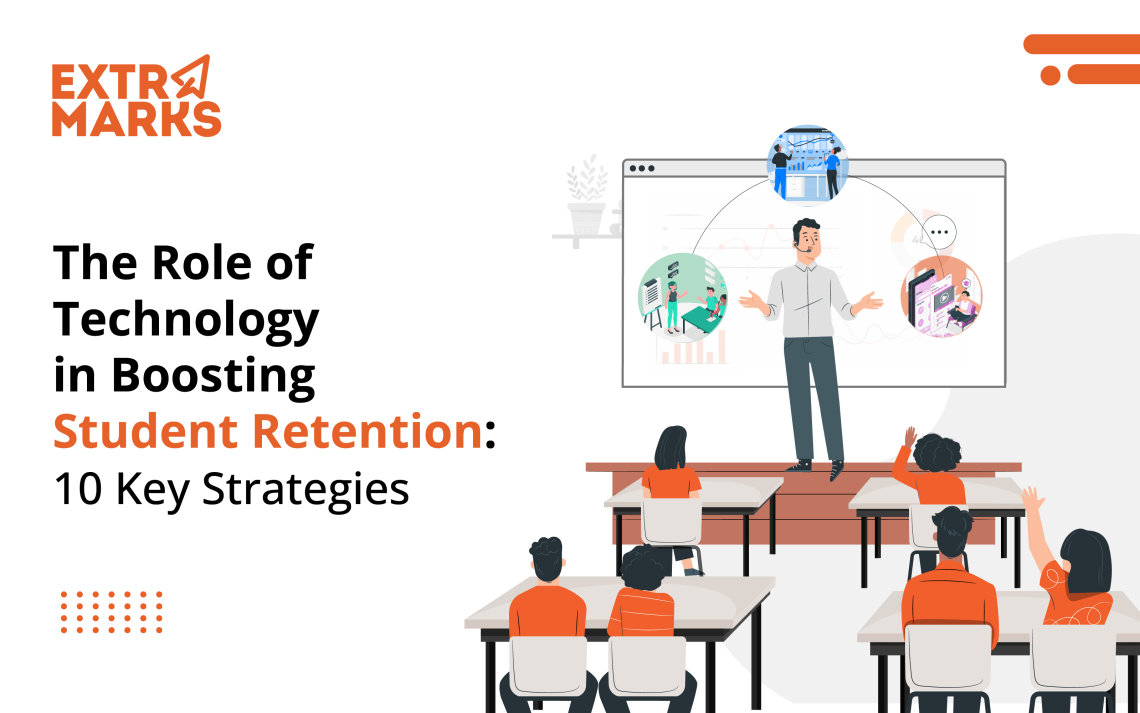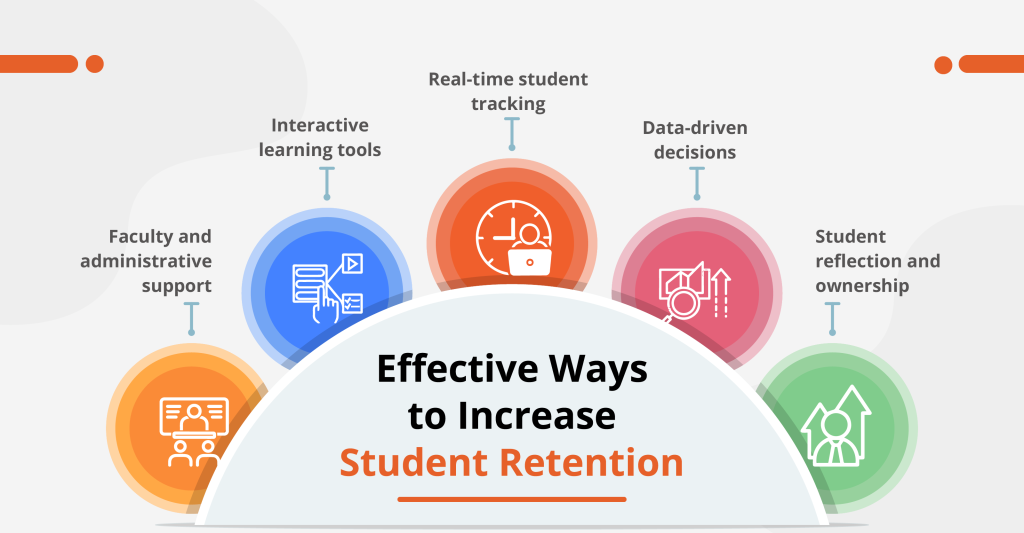The Role of Technology in Boosting Student Retention: 10 Key Strategies

India has made remarkable strides in offering access to quality education, improving school enrollment numbers and reducing drop-out rates. In fact, according to the Economic Survey 2022-23, the Gross Enrollment Ratio (GER) has improved significantly across schools with 26.5 crore enrollments and an additional 19.4 lakh students enrolled in primary to higher secondary levels. Along with student enrollments, student retention is another important metric that defines the success of students’ education as well as the academic institution.
For students, a high retention rate would indicate how an institution succeeded in providing high quality education to its students. Whereas from an institutional perspective, it means that they have successfully created an environment that promotes student success and meets all their learning needs. It is impractical to narrow down on a single reason as to why students drop out of schools as there are many. The reasons can be subjective, however, most of them fall between lack of financing to the inability to cope with the curriculum. This is why while developing strategies to improve student retention, it is essential for administrators to examine how a student is integrated into the learning environment both socially and academically. Today, thanks to the advent of technology, it has become relatively easy to track, analyze and evaluate student retention statistics by using various analytics and engagement tools.
In todays’ blog post, we take a look at the importance of student retention and why using technology to enhance student retention strategies is the best way forward.
What is Student Retention and Why is it Necessary
The growth of an educational institution is based on students completing their studies and graduating to the next academic year. Student retention essentially refers to the concept of students moving forward in a program or continuing their education in the same institution for the upcoming academic year. Student retention rate can be described as the number of students who re-enroll from one academic year to the next and successfully complete their course. A high student retention rate means a large number of students who enrolled end up graduating, whereas a low retention rate indicates that only a small percentage of students managed to complete the program. This crucial data has become immensely important in the world of education as it is reflective of the quality of education and overall assistance that students receive from an academic institution.
Student retention is considered an important metric not only for institutions and students but also parents, administrators and policymakers. A number of factors such as a students’ academic performance, financial stability, social integration, institutional support, etc. can have a direct impact on student retention.
There are two main reasons why student retention is important. Firstly, a high student retention rate signifies that students are satisfied with their learning experience and that the institution is taking the right steps to provide them with quality educational experience. This not only benefits the students, staff members and the administration but also encourages other students to join, expanding the scope for diversity. Secondly, student retention also impacts academic institutions revenue wise. It offers financial stability by ensuring a consistent stream of revenue into the school or college through the payment of tuition fees.
It is incredibly important to create effective retention strategies for students at every step of the way from the get-go. Given the rising competition among academic institutions and the demand for high quality education, developing strategies that focus on engagement is a great way to boost student’s overall learning experience.
Now that we have a better idea on what student retention means and why it is important to institutions, let’s explore how technology plays an important role in enhancing enrollment and retention of students.
How Technology Can Enhance Student Retention Strategies
In order for academic institutions to meet their enrollment goals successfully, they must execute impactful retention strategies for students to help them attain the required educational objectives. But how do we know if a retention strategy is impactful? Among the first things to consider would be practices that keep students interested, promote engagement and enhance their overall learning experience. In today’s digital landscape, technology, specifically educational technology, plays a huge role in transforming how students learn and engage. This is a great reason for educational institutions to start thinking about different ways in which technology can be integrated into the learning experience.
New technologies, particularly Artificial Intelligence (AI)-powered chatbots, SMS campaigns, live chats and predictive analysis can offer an array of benefits to institutions. The main advantages of using technology to enhance student retention strategies are that they not only provide an engaging learning platform for students but also capture and offer insightful data that teachers and administrators can use to keep up with the rapidly evolving educational landscape. Integrating technology for learning does not resolve every challenge pertaining to student retention. What it does, however, is work together with educators to provide students with a modern learning experience.
Here are five ways through which technology can help improve student retention:
1. Deploying chatbots to drive engagement
Adding AI-powered Education chatbots to the school or university website helps with student engagement and makes it easier to discover self-service tools and get any questions answered instantly. While most chatbots are automated, some institutions also deploy live assistants who are virtually present to answer any advanced questions
2. Connecting with students via messenger
Teachers can also use mobile messaging to connect with students to improve accessibility. It is a great way to reach out to students quickly, create student groups, address any questions they may have, share resources or alert them about upcoming activities, tests or events
3. Processing feedback with AI
AI technology can be used to analyze students’ feedback, chatbot responses, social media posts or any other form of digital communication with the institution. This powerful tool compiles all the data, learns students’ preferences and behaviors and accordingly creates activities and programs that align with their interests or learning needs
4. Developing online message boards to foster inclusivity
Student engagement can be a challenge especially across large campuses with students belonging to different age groups. In such situations, using online message boards is the best way to make the campus more inclusive. These message boards can be used to invite students for events, make announcements regarding fun activities, connect with student clubs and so much more
5. Utilizing targeted surveys
If a student is struggling with a particular subject or course, sending out targeted surveys can be a great way to acknowledge the challenges they may be facing and collect individual feedback. By evaluating this information, institutions can address the students’ needs, offer guidance if needed and accordingly optimize the overall student experience
Successfully implementing technology is just one aspect of improving student retention. It is important to deploy the right personnel to manage this technology, offer proper assistance to at-risk students and ensure the technology, student retention strategy and overall objectives are aligned.
Further in this blog, we explore the top ten strategies that can effectively boost student retention.
Key Strategies to Improve Student Retention

Developing a strong student retention strategy is one of the most impactful ways for institutions to meet their enrollment and admissions goals. It is a great way to keep the school budget in check and track the real costs involved in enrolling and retaining students. In the world of business, for instance, the total cost of acquiring new customers is far higher than the cost of retaining an existing customer. Similarly, the cost of admitting new students in order to maintain enrollment numbers is much higher than the total cost of retaining students who are already part of the institution.
This is why effective student retention requires an integrative approach that also considers students’ success and learning experience. We take a look at ten useful strategies to help an institution improve student retention like a pro:
1. Set clear goals and objectives
Begin by establishing what your vision of student success looks like. This definition of success can be defined by evaluating data collected through engagement with students, educators and administrators. Students are more likely to work towards a goal when they are aware of what is expected of them. Clearly define and communicate expectations by breaking down goals into achievable steps in order to support achievement. Moreover, establishing goals makes it easier to optimize the effectiveness of the strategy and measure success accurately
2. Regularly connect and engage
Guidance and support from educators can go a long way in helping students work through academic challenges and stay on track. To facilitate better school-student interaction, design effective orientation programs with engaging virtual components that complement the onboarding process. Reach out to students regarding campus services, activities, training videos, live events, etc. to help them build strong relations with peers, staff, faculty, student leaders and other members of the campus community. Some institutions aso conduct mentorship programs to support student development and often implement technology that makes it easier for students to connect with students, advisors or staff members
3. Help students in tracking progress
A great way to keep motivation levels high and encourage student engagement is to get students to see how much they have accomplished, monitor their progress and check what they still need to get done. Guiding students through intentional pathways via interactive checklists, tracks and to-do lists can help them keep track of measurable milestones. To take student learning and assessment to the next level, check out Extramarks Smart Class Plus – a cutting-edge platform that has been effectively designed to meet the needs of new-age classrooms. Besides offering an interactive learning experience with unique digital tools, the platform also has a well-rounded student assessment center where personalized test reports, progress analysis and insights into students’ strengths and weaknesses are shared. This data is useful for educators to determine the effectiveness of their lesson plans as well as for students, who can easily track their progress and make changes to their learning strategy, if needed
4. Connect students with financial resources
Finances can be a significant challenge for some students, who are, thereby, at a higher risk of dropping out of school or college. In order to support students who may be facing financial trouble, institutions could develop payment plans or offer extended timelines that allow their family the option to cover the tuition fees
5. Build a community
It is important to cultivate a sense of belonging to help students feel acknowledged and supported in their learning environment. Focusing on building supportive programs, personalizing learning and creating a strong on-campus community is going to make it easier for students to build a network and feel motivated to perform better. Encouraging students to be part of learning communities, volunteer programs or student organizations helps them be involved both in and out of the classroom and is one of the best strategies to improve student retention
6. Develop intervention processes
Implementing solid intervention processes is key for enhancing student retention. If a student appears to be going through academic, social, financial or any other challenges that puts them at the risk of dropping out, inform them about the resources, support or services that the institution can offer at the earliest. The academic faculty can make use of engagement data analytics to proactively offer timely outreach and address these students’ specific needs. Through such early intervention, educators also start to build a level of trust with students, which can sometimes make all the difference in a students’ decision to stay or leave
7. Gather feedback
One of the most simple yet effective strategies to improve student retention is to collect feedback from students to gauge their happiness levels and effectiveness of lesson plans. Making student engagement surveys and polls as part of the learning experience can help correctly determine how students feel, what struggles they may be experiencing, which aspects of the institution are they completely satisfied with and so on. These are crucial insights sourced directly from students that can help you address certain challenges right away and optimize programs accordingly
8. Collect retention data
Identifying and tracking key performance metrics such as poor attendance, low scores and lack of involvement in classes helps gain a deeper understanding into students’ persistence levels. A combination of quantitative data (education history, scores, etc.) and qualitative data (goals, challenges, etc.) can be used to create a proactive retention strategy by extracting predictive models for students’ success
9. Engage with parents
Regular communication with parents about their childs’ performance and progress is key to ensure that students receive the right kind of support. Often, students may not know how to reach out or ask for help in terms of social or academic needs. When institutions offer guidance to parents on how to support their children regarding their academic performance, involvement at school or even on mental health related aspects, it helps them support their child well. Many institutes conduct webinars to educate parents and share tips on how to better support their childs’ needs
10. Encourage autonomy
Student autonomy in a classroom is where each student takes the initiative and responsibility for their own learning. The campus administration is in a position of power to encourage an autonomous culture in many different ways. The first method is to implement guided pathways – setting attainable smart goals to help students be more engaged and track their progress. The second way is to develop mentorship or connection programs that empower students to reach out for help to faculty advisors or teachers
The most important step is to take student retention from a concept to an impactful and executable strategy. Understanding how to use the data collected, what tools to deploy, which technology to implement and how to collaborate better are all key aspects of developing and executing student retention strategies successfully!
Last Updated on January 8, 2024










